The effect of perceived service quality on patients behavioral intentions
Bạn đang xem bản rút gọn của tài liệu. Xem và tải ngay bản đầy đủ của tài liệu tại đây (1.02 MB, 11 trang )
CÁC KẾT QUẢ
NGHIÊN CỨU KHOA HỌC
VÀ ỨNG DỤNG CÔNG NGHỆ
SỐ
8
- THÁNG 8/2016
Website:
TỔNG BIÊN TẬP
ThS. Đặng Thị Ngọc Thu
ĐT: 04.62694445 - 0903231715
PHÓ TỔNG BIÊN TẬP
Ngô Thị Diệu Thúy
ĐT: 04.22218228 - 0903223096
CÁC KẾT QUẢ
NGHIÊN CỨU KHOA HỌC
VÀ ỨNG DỤNG CÔNG NGHỆ
TÒA SOẠN
Tầng 8, số 655 Phạm Văn Đồng,
Bắc Từ Liêm, Hà Nội
Ban Trị sự - ĐT: 04.22218238
Fax: 04.22218237
SỐ
8
Ban Thư ký - Xuất bản
- THÁNG 8/2016
Website:
ĐT: 04.22218230
Ban Biên tập - ĐT: 04.62701436
Ban Phóng viên - ĐT: 04.22218239
Ban Chuyên đề - ĐT: 04.22218229
HỘI ĐỒNG BIÊN TẬP
TS. Trần Tuấn Anh
Ban Tạp chí Công Thương Điện tử
ĐT: 04.22218232
Email:
GS.TS. Đinh Văn Sơn
GS.TS. Trần Thọ Đạt
GS.TS. Nguyễn Bách Khoa
GS.TSKH. Đặng Ứng Vận
GS.TSKH. Đỗ Ngọc Khuê
VĂN PHÒNG ĐẠI DIỆN PHÍA NAM
Số 173 Hai Bà Trưng, Phường 6,
Quận 3, TP. Hồ Chí Minh
ĐT: (08) 38213488 - Fax: (08) 38213478
Email:
PGS.TS. Lê Văn Tán
GS.TSKH. Bành Tiến Long
GS.TS. Trần Văn Địch
GS.TS. Phạm Minh Tuấn
GS.TSKH. Nguyễn Xuân Quỳnh
GS.TS. Võ Khánh Vinh
Giấy phép hoạt động báo chí số:
60/GP-BTTTT
Cấp ngày 05/3/2013
Trình bày: Tại Tòa soạn
In tại Công ty CP Đầu tư và
Hợp tác quốc tế
Giá 20.000 đồng
Website: www.tapchicongthuong.vn
muïC luïC
Contents
ISSN: 0866-7756 Số 8 - Tháng 8/2016
LUẬT - KINH TẾ
ĐẶNG CÔNG TRÁNG - BÙI THỊ HẢI ĐĂNG
Quy định về cách xác định biên độ bán phá giá trong Pháp lệnh Chống bán phá giá 2004
The calculations of dumping margins in the Ordinance on Anti-dumping of Import into Vietnam 2004......................5
ĐẶNG CÔNG TRÁNG - TRẦN THỊ TÂM HẢO
Quy định của pháp luật Việt Nam về căn cứ xác định bán phá giá hàng hóa nhập khẩu
The provisions of Vietnam’s law on determining the dumping behavior of imports into Vietnam ...............................9
ĐỖ HẢI ĐĂNG - NGÔ TUẤN ANH
Chương trình mục tiêu quốc gia xây dựng nông thôn mới thời gian qua và những kiến nghị
The implementing the Vietnam's national target program on new rural development and recommendations ...........13
LÊ THANH TÙNG
Thực trạng thu hút vốn FDI vào bất động sản tại TP. Hồ Chí Minh từ khi gia nhập WTO - Dự báo và khuyến nghị
The actual situation of attracting FDI capital into the real estate sector in
Ho Chi Minh Citysince joining WTO till now - Predictions and Recommendations
Impacts of WTO Agreement on Agricutlure on ensuring food security of Vietnam..................................................18
BÙI KIM NGÂN
Tác động của Hiệp định về nông nghiệp của WTO (AoA) đến việc đảm bảo an ninh lương thực Việt Nam
Impacts of WTO Agreement on Agriculture on ensuring food security food security of Vietnam..............................27
LƯU BÌNH DƯƠNG
Cần sửa đổi quy định về khởi tố vụ án hình sự theo yêu cầu của bị hại trong BLTTHS
để đáp ứng yêu cầu tự do kinh doanh, thương mại hiện nay
The need of modifying provisions of criminal prosecutions to meet the requirements of free business today ...........33
TRẦN THÀNH THỌ
Phát triển ngành Công nghiệp hỗ trợ: Hướng về kết nối chuỗi cung ứng
Developing supporting industry towards connecting supply chain.........................................................................38
LÊ ĐỨC NHÃ
Những tác động của TPP đối với hoạt động FDI tại Việt Nam
The impact of the TPP on FDI capital in Vietnam ................................................................................................42
NGUYỄN THỊ KIỀU NGA
Nâng cao hiệu quả hợp tác và phát triển thương mại của Việt Nam khi gia nhập AEC
Improving the efficiency of cooperation and trade development of Vietnam when joing AEC..................................48
BÙI QUANG TÍN
Bảo vệ quyền lợi của khách hàng trong hoạt động sáp nhập, hợp nhất và mua lại
ngân hàng thương mại dưới góc nhìn từ pháp luật
Protecting customer’s intereset in M&A progresses of the commercial banks under the Law on Deposit Insurance ......54
QUẢN TRỊ - QUẢN LÝ
TRẦN MINH HOÀNG
Năng lực lãnh đạo nhân sự quản lý khu vực hành chính công: Cách tiếp cận theo khung năng lực
The leadership competencyfor managers of the public administration sector
under the approach of competency framework ...................................................................................................60
TRẦN ĐĂNG KHOA
Ảnh hưởng của hoạt động CSR đến niềm tin và nhận thức rủi ro của khách hàng
The impact of CSR on trust and risk perceptions of customer ..............................................................................66
TRƯƠNG THỊ THẢO
Những vấn đề cần đổi mới của doanh nghiệp vừa và nhỏ khi tham gia Hiệp định Đối tác xuyên Thái Bình Dương
Innovative issues of SMEs when Vietnam participated TPP agreement .................................................................71
BÙI HUY KHÔI
Building university’s reputation in integrating TPP
Xây dựng danh tiếng trường đại học trong bối cảnh hội nhập TPP .......................................................................75
PHẠM MINH TUẤN
Phân tích thực trạng lưới điện phân phối tỉnh Lạng Sơn, đề xuất giải pháp nâng cao độ tin cậy cung cấp điện
Analyzing the situation of electric distribution network
to find solution to enhance the reliability in power supplies in Lang Son province..................................................80
LÊ BÍCH CHÂM - TRƯƠNG QUANG THÁI - TRẦN ĐÌNH THỨC - NGUYỄN ĐỨC NGUYÊN
The effect of perceived service quality on patients’ behavioral intentions
- A case study in provincial hospitals in Ho Chi Minh City
Ảnh hưởng của chất lượng cảm nhận dịch vụ đối với ý định thực hiện hành vi của
bệnh nhân tại các bệnh viện của TP. Hồ Chí Minh ...............................................................................................86
TRƯƠNG ĐỨC THAO - DƯƠNG MINH TÚ
Giải pháp phát triển đội ngũ giáo viên tại các trường đại học ngoài công lập
Solutions to develop lectuters force in non-public uninesities and colleges in Vietnam ...........................................93
VŨ NGỌC LOAN
Giải pháp vượt qua rào cản kỹ thuật của Nhật Bản đối với hàng rau quả Việt Nam
Solutions to overcome technical barriers to trade of Japanese market for Vietnamese vegetable ............................97
KINH DOANH
VŨ TUẤN LINH
Ý nghĩa và các tiêu chí đánh giá hiệu quả sử dụng vốn của doanh nghiệp
The meaning and criteria for efficient use of capital .........................................................................................103
NGUYỄN THỊ THU HẰNG - NGUYỄN THANH TÙNG
Ảnh hưởng của năng lực tâm lý đến hiệu quả công việc của nhân viên trong ngành Dịch vụ tại TP. Hồ Chí Minh
The impact of psychological capital on job performance of employees who
work in providing service sector in Ho Chi Minh City..........................................................................................108
PHAN TUYẾT THANH
Nghiên cứu nhu cầu về nhà ở chung cư của cư dân Hà Nội và vận dụng của các công ty kinh doanh bất động sản
Studying the demand of deparment in Hanoi City and the real estate companies’ understanding demand .............116
NGUYỄN VĂN TRỊ
Phát triển kênh phân phối góp phần nâng cao hiệu quả sản xuất kinh doanh thiết bị điện, động cơ điện
Developing distribution channel to improve business performance
of manufacturers’ electrical devices and electrical motors ..................................................................................121
NGUYỄN XUÂN BẮC - CAO THU HÀ - PHẠM THỊ THANH HỒNG
Giải pháp nhằm tăng cường khả năng cạnh tranh trên thị trường phân đạm urê
Solutions to strengthen domesitc fertilizer producers’ competitiveness in urea fertilizer market.............................126
TÀI CHÍNH - NGÂN HÀNG - BẢO HIỂM
NGUYỄN THỊ TUYẾT NGA
Tái cấu trúc ngân hàng Việt Nam tác động đến sự phát triển tài chính để hội nhập TPP
The impact of restructuring progress of Vietnam’s
banking system on the growth of financial sector for TPP integration .................................................................131
ĐÀNG QUANG VẮNG - ĐOÀN THANH VŨ
Phân tích mối quan hệ giữa rủi ro thanh khoản và hiệu quả hoạt động của ngân hàng thương mại Việt Nam
Analyzing the relationship between liquidity risk and business performance ........................................................138
of Vietnam’s commercial banks
KẾ TOÁN - KIỂM TOÁN
PHAN HƯƠNG THẢO
Vai trò của kế toán quản trị hàng tồn kho trong điều hành doanh nghiệp
The role of inventory management accounting in business management ............................................................144
PHẠM NGỌC TOÀN
Nghiên cứu ảnh hưởng của thông tin kế toán doanh nghiệp đến quá trình hành thu và
kiểm soát thuế tại các chi cục thuế TP. Hồ Chí Minh
Studying the impact of business accounting information on collecting and controlling taxes
procedure of tax departments in Ho Chi Minh City ............................................................................................149
LÊ THỊ MỸ NƯƠNG - HOÀNG THỊ HIỀN - PHẠM NGỌC TOÀN
Các nhân tố bên trong công ty kiểm toán tác động đến chất lượng kiểm toán trên địa bàn TP. Hồ Chí Minh
Internal factors of auditing in Ho Chi Minh City which impact to the audit quality ................................................154
tạp chí công thương
tHe effeCt of PeRCeIVed seRVICe
QuAlItY on PAtIents BeHAVIoRAl
IntentIons - A CAse studY In PRoVInCIAl
HosPItAls In Ho CHI mInH CItY
l LÊ BÍCH CHÂm
l TRƯƠNG QUANG THÁI
l TRN ĐÌNH THỨC
l NGUYN ĐỨC NGUYÊN
ABstRACts:
This research aims to elaborate the association between perceived service quality and the
patients intention of behaviors via the mediate variable being patients fulfillment. Besides, the
study also estimates the existence of patients appreciation on the healthy services components.
Finally, the work additionally suggests some management implications for the hospitals
managers and state agencies to improve the patients satisfaction.
Key words: Service quality, Public hospital, Patients satisfaction, SEM analysis.
1. Introduction
Healthcare is one of the essential sectors in
service industry of every country. According to
PwC report in June 2014, which discusses on the
Vietnamese healthcare industry, this industry has
been one of among the most dramatic growing and
high potential sectors in Vietnam. Furthermore,
this report reveals that Vietnamese patients spend
much time just for finding their trusted hospitals,
which are normally the overcrowded national level
hospital such as K hospital (250% occupancy rate in
2009), Cho Ray hospital (139%), Bach Mai hospital
(168%), etc. It follows therefore that the patients
perception of service quality in other small
provincial hospitals is still questioned. In other
words, these hospitals need a significant
improvement for decreasing the overloading
situation in mentioned bigger hospitals.
2. literature Review
2.1. Perceived healthcare service quality
For quite a while, there have been numerous
86 Số 8 - Tháng 8/2016
efforts by researchers to explain and calculate
service quality. For instance, according to
(Lehtinen & Lehtinen, 1982), two perspectives
should be looked upon when it comes to assessing
the quality of service; (1) the process of service
provider and (2) the outcomes of the service. In
addition, Gr#nroos (1984) additionally proposed
that service quality consist of initially technological
quality, which is what the clients retain, and
secondly functional quality that illustrates the ways
in which service is offered. As mentioned
bySpreng, MacKenzie, and Olshavsky (1996),
before using a service, customers already had a
script; an expectation about the service formed in
their mindset and the difference in the screenplay
of consumers and suppliers will lead to
dissatisfaction. Another view recommended by
Cronin Jr and Taylor (1992) is that there is a need to
analyze consumers contentedness briefly while the
attitudes of consumers should be evaluated for
longer period of time. Nevertheless, in the topic of
Quaûn trò - Quaûn Lyù
service quality, it is indispensable to acknowledge
the important contribution ofArun Parasuraman et
al. (1988) who mentioned that the contrast between
clients expectation of services and their valuation
of the service payoff defines service quality.
2.2. Patient satisfaction
The definition of user satisfaction has been
broadly researched in a variety of fields and areas
of study including marketing, commerce and
management. One of the inaugural and highly cited
definitions of satisfaction is offered by Locke
(1976) in the circumstance of outcomes of works.
Satisfaction is defined as a favorable or positive
affective status leading from the appreciation of
persons assign(Locke, 1976). Oliver (1981)
enlarged this definition in the circumstance of the
consumption circumstance as “the summary
psychological state resulting when the emotion
surrounding disconfirmed expectations is coupled
with the consumers prior feelings about the
consumption experience”.
In order to describe the unresolved conceptual
difficulties with the patients satisfaction, Oliver
(1981) supposed that satisfaction consists of
psychological state and encounter specific; the
gratification response and experiential construct
(Oliver, 1997), etc.
2.3. Repurchase Intention
Repurchase can be defined as a repeated buying
or purchasing of goods or services from the same
providers. In other words, the customer comes back
to the organization or is retained. This brings about
the term loyalty. Repurchase (or loyalty)
contributed greatly to profit and growth of an
organization as it leads to an increase in purchasing
of goods, willingness to pay higher premiums
(thereby increasing profit margin) as well as a fall
in advertising cost and decreased vulnerability to
present competition [(Anderson, Fornell, &
Lehmann, 1994), Heskett and Schlesinger (1994)].
2.4. Word of mouth (WOM) communication
The process of exchanging information or
opinions related to topic of product or service is
calledWord-of-Mouth. There are ways through
which Word-of-Mouthmay be interchange from a
certain individual to another one including oral or
written communication. As communicators are
separated from the market, it is more trustworthy
and convincing the conventional media channels
(Chen & Berger, 2013).
Word of mouth marketing has ceased to be alien
concept to people for a long time. According to the
most basic definition offered by Sernovitz, Godin,
and Kawasaki (2009), this is a form of marketing,
which is done based on the routine exchange,
communicated in human language. In the word of
mouth marketing, the recipient receives
information about the brand, product or service
from a non-commercial convey
2.5. Relationship between service quality and
customer satisfaction
One of the most impactful factors of customer
satisfaction is service quality [Cronin Jr and Taylor
(1992), Yavas, Bilgin, and Shemwell (1997), Jamal
and Naser (2002)]. The providers can make their
consumers happy by in the first place, provide a
good quality products that meet the requirement of
the consumers.
As such, there is the need for providers to
improve the service quality in order to boost
customer satisfaction. In other words, there is a
positive direct relationship between service quality
and customer satisfaction. Service quality has been
created first upon which customer satisfaction is
decided.
2.6. Relationship between customer satisfaction
and repurchase intention
There is argument stating that high level of
repurchase is dependent on the level of customer
satisfaction. Oliver (1997)mentioned that repeat
purchasing is fundamental to a continued stream of
profitability through achieving higher levels of
customer satisfaction. Hence, beside avoid
dissatisfaction; management should pay attention
to fostering satisfaction (Oliver, 1997). Keeping
this idea in mind, many has made customer
satisfaction as a corporate goal among academics
and business practitioners (Rust & Oliver, 1993).
2.7. Relationship
between
customers
satisfaction and word-of-mouth
WOM has been identified, in some studies, as a
primary source of informational influence in
consumer repurchase decision-making as well as a
channel for customers to express satisfaction or
dissatisfaction with a service experience Spreng et
al. (1996).
Soá 8 - Thaùng 8/2016
87
taïp chí coâng thöông
As mentioned by(Frenzen & Nakamoto, 1993),
the effect on customer satisfaction by word of
mouth is one of the most fundamental bases of
positive word of mouth. Gotlieb et al.
(1994)confirmed that there is a positive correlation
between customer satisfaction and positive word of
mouth. In addition, according to Swanson and
Charlene Davis (2003), word of mouth
communication is perceived to be a very typical
and crucial form of communication for service
marketers, and for maintaining a base of long-term
customers. Agreeing with these researchers (West,
Patterson, Lawthom, & Nickell, 1997) discovered
that there is a positive relation between customer
satisfaction and positive word of mouth.
2.8. Relationship between repurchase intention
and word-of-mouth
According to (Ennew, Banerjee, & Li, 2000),
purchases increase with positive WOM from
satisfied customers. Moreover, Gremler and
Brown (1996) recommend that customers who are
willing to offer positive WOM communications are
more likely to become loyal customers. Besides,
positive WOM is extremely important advertising
tool for providers. According to early studies, it is
nine times as effective as traditional advertising
(Mazzarol, Sweeney, & Soutar, 2007).
The structural equation model hypothesized that
there is a positive correlation between repurchase
and positive word-of- mouth. Other studies in the
marketing literature support this relationship
[Zeithaml (2000), Anderson et al. (1994)]
figure 2: Research model
88 Soá 8 - Thaùng 8/2016
H1 Perceived Quality has apositive impact on
patients satisfaction.
H2 Patient satisfaction has apositive impact on
repurchase intention.
H3 Patient satisfaction has a positive impact
on word-of-mouth.
H4 Word-of-mouth has a positive impact on
repurchase intention.
3. methodology
The process of the study comprises two
conjunctive steps being preliminary research
(using qualitative method) and authentic one (using
quantitative method). The questionnaire will be
delivered to the 18-year old and above who used to
or are examining and to be under medical
treatment at public hospitals 2-level of Ho Chi
Minh City including: An Binh Hospital, Saigon
Polyclinic Hospital, Mental Hospital, Hospital for
Rehabilitation and Professional Diseases,
Traditional Medicine Hospital.
In order to meet the researchs targets, the author
uses the non-probability sampling, specifically the
convenient with approximately 300 answer sheets
with the 5- point Likert Scale.
In the analytical step of collected data,
Exploratory Factor Analysis as well as Test of the
scales reliability initially conducted to determine
factors belonging to the research model from items
and to test preliminarily reliability of the scales.
Later, the technique namely Confirmatory Factor
Analysis (CFA) is used to test the scales validity
both convergent validity and discriminate validity,
and the factors appropriateness as well.
Meanwhile,
the
author
additionally computed the scales
composite
reliability
and
extracted variance. Finally, the
author uses the method named
Structural Equation Model (SEM)
to test hypotheses of the research
model. All above techniques are
implemented
by
statistical
software namely SPSS 22.0 and
AMOS 22.0.
4. Result
The data collecting was
conducted over a period from
Hypothesis Description February, 2016 to March, 2016.
Quaûn trò - Quaûn Lyù
There were 311 answer sheets
returned among 350 dispatched ones,
but there were the most 300 relevant
used for the analytical stage.As
illustrated in 4.1. The characteristics
of the sample are showed as follows.
The result of EFA and Cronbachs
Alpha shows that there are 12 factors
with 56 items.All items putted into
running Cronbachs alpha and
Exploratory Factor Analysis have
factor loading being more than 0.5 as
well as Cronbachs Alpha index being
more than 0.7.
The results of CFA, computing
factors composite reliability and
Tablie 4.1: The result of the sample’s descriptive statistics
extracted variance shows that the
scales are probably expected to meet
requirements about the scales reliability and
validity. All composite reliabilities are from
0.813 to 0.890 (more than 0.7), and Extracted
Variances are all over 0.5. In addition, all
indicators have value fluctuating from 0.651 to
0.849 (more than 0.5). Therefore, all observable
variables are relevant to analyze. As presented
in the figure 4.1, some indexes including TLI,
CFI, GFI (>0.9), CMIN/df<2, and RMSEA<0.06.
Therefore, the scales are relevant to practice
data.
The results of the factors means, standard
deviation, and correlation indexes are
representedin the following table named 4.2.
Looking at the column named Mean, it is
The figure 4.1: The result of CFA fir tge scakes after extracting effortlessly seen that the patients underestimate
the
relationship
between
medical
workers and them,
interaction between
medical workers and
them,
hospital
facilities,
and
compliance of time,
with valued at 2.589,
3.066, 3.067, 3.087,
respectively.
The
other factors have
higher estimations,
Table 4.2: The means, standard deviation and the correlations between the factors but also are still quite
Soá 8 - Thaùng 8/2016
89
taïp chí coâng thöông
low (less than 3.5). Among all aspects surveyed, the
Outcome and Expertise have the most valuation
with approximately 3.4 point per 5-point scale.
The author uses AMOS 20 to run the Structural
Equation Model and has the following outcome
(showed in the figure 4.2 and the table 4.5).
The above table illustrates that among sub
dimension of Perceived Service Quality, the
“Administrative” has the most important role with
standardized coefficient being 1.008. In contract,
the “Interpersonal” has the least effect with
standardized coefficient being 0.810. Furthermore,
90 Soá 8 - Thaùng 8/2016
the performance also shows that patients
satisfaction has significant impact on their intention
of repurchase with standardized total effect about
0.836 including the standardized direct of 0.284,
and the standardized indirect of 0.605. For word of
mouth, patients fulfillment additionally has
important role in increasing
positive spread out of the
hospitals prestige. It is
effortlessly understandable
that
pubic
medical
organizations in Vietnam
virtually use Word of Mouth
marketing, and patients
almost believe some certain
infirmaries treatments and
examinations through their
relatives introductions.
Briefly, the results of
testing the research model
and
hypotheses
are
illustrated in the following
table:
Look at the table 4.4, it is
can be seen that 300
surveyed patients have the
low degree of satisfaction;
this causes the negative
(unexpected)
behavioral
intentions. To be more
specific, the Repurchase
and Word of mouth have not
high marks. However, this is
the result of the sample, the
question needed to answer
that how much the research
populations satisfaction as
well as future intention is. In
order to answer the
question, the author uses the
test named One-sample TTest.
As illustrated in the above table, the Satisfaction
of population has value from 3.197 to 3.347 with
confidence of 95%. Meanwhile, those numbers of
Repurchase, Word of mouth are from 3.187 to
3.348; and from 3.188 to 3.379 respectively.
Following the result, there is the difference of
Quaûn trò - Quaûn Lyù
level of patients satisfaction by gender in the
survey. Specifically, compared with the female
patients, the male have higher satisfaction of
healthcare services.
The result of Levene Test shows that the variance
of the two groups were similar, and the result of
Independent Samples Test illustrates that the
difference in satisfaction levels on the medical
service quality can deduce the population with the
confidence of 95%, proved by Sig = 0.017
<0.05.Additional, there is no evidence to prove the
difference of level of patients satisfaction by the age
in the survey. Specifically, it is elucidated by Sig
value of 0.258, more than 0.05.Similarly, there is no
evidence to prove the difference of level of patients
satisfaction by the income in the survey. Specifically,
it is elucidated by Sig value of 0.6, more than 0.05.
5. Conclusions and discussions
This studys main purpose is to evaluate the
impact of perceived quality value of healthcare
services provided by the 2-level public hospitals on
the patient's satisfaction. Then, the satisfactions
impacts
on
the
patients
behavioral
intentionincluding continuing to use the hospitals
services, the sick persons word of mouth are
appreciated. The research subject in the article is
the quality of medical services supplied by 2-level
public hospitals in Ho Chi Minh City.
The result of testing the researchs hypotheses
shows that all assumptions are accepted. In particular,
the patients perceived quality of health services has
effect on theirsatisfaction;the patients satisfaction has
a direct impact on the re-use of medical services
provided by the hospitals, and has indirect impact on
the re-use of medical services provided by the
hospitals through the patient's word of mouth.
The additional tests are conducted to examine
the differences of the level of the patients
satisfaction under demographic variables such as
gender, age, and income. The results show that
there is only difference of the satisfaction between
the two groups of male and female patients. There
is no difference of the satisfaction among income
and age groups n
RefeRenCes:
1. Anderson, E. W., Fornell, C., & Lehmann, D. R. (1994). Customer satisfaction, market share, and profitability:
Findings from Sweden. the Journal of Marketing, 53-66.
2. Chen, Z., & Berger, J. (2013). When, why, and how controversy causes conversation. Journal of consumer
research, 40(3), 580-593.
3. Cronin Jr, J. J., & Taylor, S. A. (1992). Measuring service quality: a reexamination and extension. The Journal
of Marketing, 55-68.
4. Fornell, C., & Wernerfelt, B. (1988). A model for customer complaint management. Marketing Science, 7(3),
287-298.
5. Frenzen, J., & Nakamoto, K. (1993). Structure, cooperation, and the flow of market information. Journal of
consumer research, 360-375.
6. Gremler, D. D., & Brown, S. W. (1996). Service loyalty: its nature, importance, and implications. Advancing
service quality: A global perspective, 171-180.
7. Gronroos, C. (1984). A service quality model and its marketing implications. European journal of marketing,
18(4), 36-44.
8. Heskett, J. L., & Schlesinger, L. (1994). Putting the service-profit chain to work. Harvard business review,
72(2), 164-174.
9. Jamal, A., & Naser, K. (2002). Customer satisfaction and retail banking: an assessment of some of the key
antecedents of customer satisfaction in retail banking. International Journal of bank marketing, 20(4), 146-160.
10. Lehtinen, U., & Lehtinen, J. R. (1982). Service quality: a study of quality dimensions: Service Management Institute.
11. Locke, E. A. (1976). The nature and causes of job satisfaction. Handbook of industrial and organizational
psychology, 1, 1297-1343.
12. Mazzarol, T., Sweeney, J. C., & Soutar, G. N. (2007). Conceptualizing word-of-mouth activity, triggers and
conditions: an exploratory study. European journal of marketing, 41(11/12), 1475-1494.
13. Oliver, R. L. (1981). Measurement and evaluation of satisfaction processes in retail settings. Journal of retailing.
14. Oliver, R. L. (1997). Satisfaction: A behavioral perspective on the customer. New York.
Soá 8 - Thaùng 8/2016
91
tạp chí công thương
15. Olshavsky, R. W. (1985). Perceived quality in consumer decision making: an integrated theoretical
perspective. Perceived quality, 4, 3-29.
16. Parasuraman, A., Zeithaml, V. A., & Berry, L. L. (1988). Servqual. Journal of retailing, 64(1), 12-40.
17. Rust, R. T., & Oliver, R. L. (1993). Service quality: New directions in theory and practice: Sage Publications.
18. Sernovitz, A., Godin, S., & Kawasaki, G. (2009). Word of mouth marketing: How smart companies get people
talking: Kaplan New York.
19. Spreng, R. A., MacKenzie, S. B., & Olshavsky, R. W. (1996). A reexamination of the determinants of consumer
satisfaction. The Journal of Marketing, 15-32.
20. Swanson, S. R., & Charlene Davis, J. (2003). The relationship of differential loci with perceived quality and
behavioral intentions. Journal of services Marketing, 17(2), 202-219.
21. Taylor, S. A. (1994). Distinguishing service quality from patient satisfaction in developing health care
marketing strategies. Journal of Healthcare Management, 39(2), 221.
22. Taylor, S. A., & Baker, T. L. (1994). An assessment of the relationship between service quality and customer
satisfaction in the formation of consumers' purchase intentions. Journal of retailing, 70(2), 163-178.
23. West, M., Patterson, M., Lawthom, R., & Nickell, S. (1997). The Impact of People Management Practices on
business performance. IPD Research Paper, 22.
24. Yavas, U., Bilgin, Z., & Shemwell, D. J. (1997). Service quality in the banking sector in an emerging economy:
a consumer survey. International Journal of bank marketing, 15(6), 217-223.
25. Zeithaml, V. A. (1988). Consumer perceptions of price, quality, and value: a means-end model and synthesis of
evidence. the Journal of Marketing, 2-22.
26. Zeithaml, V. A. (2000). Service quality, profitability, and the economic worth of customers: what we know and
what we need to learn. Journal of the academy of marketing science, 28(1), 67-85.
Received: August 2, 2016
Accepted for Publication: August 23, 2016
Corresponding author:
le BICH CHAm, tRuonG QuAnG tHAI, tRAn dInH tHuC, nGuYen duC nGuYen
facultg of Business Administration, da la university
ẢnH HƯỞnG CA CHẤt lƯnG CẢm nHẬn dỊCH Vụ ĐI VỚI
Ý ĐỊnH tHC HIn HÀnH VI CA BnH nHÂn tI CÁC
BnH VIn CA tHÀnH PH H CHí mInH
l LÊ BÍCH CHÂm
l TRƯƠNG QUANG THÁI
l TRN ĐÌNH THỨC
l NGUYN ĐỨC NGUYÊN
Khoa Quản trò kinh doanh, Trường Đại học Đà Lạt
tm tẮt:
Nghiên cứu này nhằm phân tích các mối liên hệ giữa chất lượng cảm nhận dòch vụ với ý đònh
thực hiện hành vi của bệnh nhân. Bên cạnh đó, nghiên cứu này cũng đánh giá sự ghi nhận của bệnh
nhân đối với các dòch vụ y tế. Nghiên cứu đưa ra một số gợi ý trong công tác quản lý đối với các nhà
quản lý bệnh viện và cơ quan quản lý nhà nước nhằm nâng cao sự hài lòng của bệnh nhân.
từ khóa: Chất lượng dòch vụ, bệnh viện công, sự hài lòng của khách hàng, phân tích SEM.
92 Số 8 - Tháng 8/2016

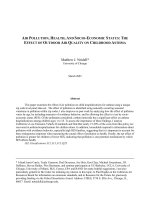
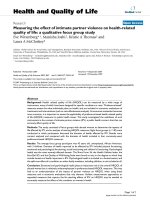

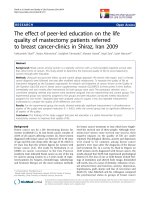
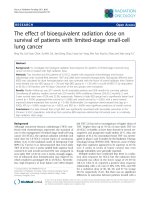

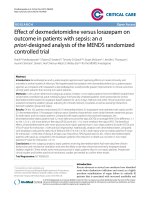
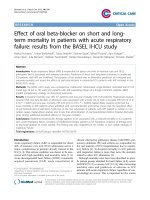
![ionescu - 2014 - the effect of mandatory partner rotation on audit quality [mapr]](https://media.store123doc.com/images/document/2015_01/06/medium_fam1420548198.jpg)